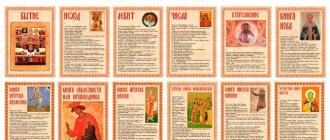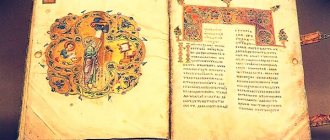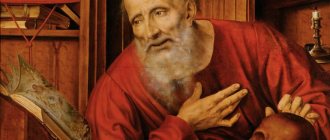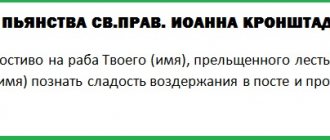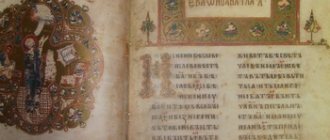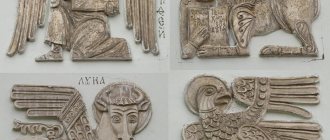Author.
The author's name is not mentioned in the text. In general, this is not surprising, because in their literary form the Gospels differ from epistles or letters. Thus, the Apostle Paul began each of his epistles by indicating his name, as was customary in the ancient world. But as for the compilers of the four Gospels, not one of them calls himself by name. And yet, as authors, they did not remain unknown. For in the course of their work, they “revealed themselves” in an indirect form, or their names became known, conveyed to descendants by legends.
The so-called internal evidence of who exactly wrote the fourth Gospel constitutes a whole chain. 1) The word “this” (used in the second case - “and he wrote this”) in John. 21:24 refers to the entire Gospel, not just the last chapter. 2) “This disciple” in 21:24 refers to the disciple “whom Jesus loved” (21:7). 3) From 21:7 it is clear that this special disciple of Jesus was one of the seven listed in 21:2 (Simon Peter, Thomas, Nathanael, two sons of Zebedee and two not named).
4) “The disciple whom Jesus loved” reclined near the Lord at the Last Supper, and Peter “made a sign” to him (13:23-24). 5) He had to be one of the twelve disciples, since only they were with the Lord at the Last Supper (Mark 14:17; Luke 22:14). 6) From the gospel narratives it follows that John had a close relationship with Peter and, together with him, was one of the three disciples especially close to the Lord (John 20:2-10; Mark 5:37-38; 9:2-3; 14:33). Since James, John's brother, was killed in 44 A.D. (Acts 12:2), he could not be the author of this Gospel.
7) The expression “another disciple” in John. 18:15-16 probably refers to the same disciple “whom Jesus loved,” since both expressions are used of the same person in 20:2. Jesus' beloved disciple stood near the cross (19:26), and what is said in 19:35, following this whole "logical chain", refers to him. 9) “Closing it,” let us refer to the words of the author of the fourth Gospel: “and we saw His glory” (1:14), which could only be said by an eyewitness to what happened (compare 1 John 1:1-4).
18:15-16 probably refers to the same disciple “whom Jesus loved,” since both expressions are used of the same person in 20:2. Jesus' beloved disciple stood near the cross (19:26), and what is said in 19:35, following this whole "logical chain", refers to him. 9) “Closing it,” let us refer to the words of the author of the fourth Gospel: “and we saw His glory” (1:14), which could only be said by an eyewitness to what happened (compare 1 John 1:1-4).
So, all these facts, brought together, convincingly indicate that the author of the fourth Gospel was precisely John, one of the sons of the Galilean fisherman Zebedee.
External evidence is the affirmation of church tradition, which initially declared John, the son of Zebedee, to be the author of the fourth Gospel. Let us refer to Polycrates, who lived in 69-155. according to R.H., who personally knew the Apostle John. Irenaeus (130-200 AD), Bishop of Lyons, testified from the words of Polycrates that “John, the disciple of the Lord, reclining at His breast, compiled the Gospel during the days of his residence in Asia, in the city of Ephesus” ( book “Against Heresies”). Polycrates, Clement of Alexandria, Tertullian and other later Church Fathers supported this point of view. And Eusebius clarified that two of the apostles - Matthew and John - wrote Gospels bearing their names ("History of the Church").
Gospel of John
1
After this, Jesus went to the other side of the Sea of Galilee, or Tiberias.
2
And many people followed Him, because they saw the signs that He performed on the sick.
3
Jesus went up the mountain and sat there with His disciples.
4
And Passover, the Jewish holiday, was approaching.
5
Jesus, looking up and seeing that many people were coming to Him, said to Philip: Where can we buy bread for them to eat?
6
He said this, testing him, for He Himself knew what He would do.
7
Philip answered Him: There is not enough bread for them for two hundred denarii, so that everyone can receive at least a little.
8
One of His disciples, Andrew, brother of Simon Peter, said to Him:
9
There is a boy here, and he has five barley loaves and two fish. But what is this for such a multitude?
10
Jesus said: Tell the people to lie down. There was a lot of grass in this place. So they reclined: the men numbered about five thousand.
11
He took the loaves and, having given thanks, distributed them to those reclining; also as many fish as they wanted.
12
When they were satisfied, He said to His disciples: Gather up the remaining pieces so that nothing is lost.
13
And they gathered and filled twelve baskets with the fragments of the five barley loaves that were left over from those who had eaten.
14
Then the people, seeing the sign created by Him, began to say that He was truly the prophet who was coming into the world.
15
Jesus Himself, having learned that they were going to come and capture Him in order to make Him king, withdrew again to the mountain alone.
16
When evening came, His disciples went down to the sea
17
and, getting into the boat, they headed to the other side of the sea to Capernaum. And darkness had already come, and Jesus had not yet come to them.
18
And the sea, with a strong wind, was agitated.
19
So, having rowed about twenty-five or thirty furlongs, they saw Jesus walking on the sea and approaching a boat, and they were afraid.
20
He says to them: It is I, do not be afraid.
21
They wanted to take Him into the boat, and immediately the boat was near the land where they were sailing.
22
The next day, the crowd that had gathered on the other side of the sea saw that there was no other boat there except one, and that Jesus did not enter the boat with His disciples, but His disciples went alone.
23
Other boats arrived from Tiberias, close to the place where they were eating bread for thanksgiving to the Lord.
24
When the crowd saw that neither Jesus nor His disciples were there, they themselves got into boats and came to Capernaum, looking for Jesus.
25
And having found Him on the other side of the sea, they said to Him: Rabbi, when did You arrive here?
26
Jesus answered them and said, “Truly, truly, I say to you, you seek Me, not because you saw the signs, but because you ate the loaves and were filled.”
27
Make for yourselves not food that perishes, but food that endures to eternal life, which the Son of Man will give you. For God the Father sealed Him.
28
Then they said to Him: How should we act to do the works of God?
29
Jesus answered and said to them: This is the work of God, that you believe in Him whom He sent.
30
They said to Him: What sign are You giving, so that we may see and believe You? What are you doing?
31
Our fathers ate manna in the desert, as it is written: “He gave them bread from heaven to eat.”
32
Jesus said to them, “Moses did not give you bread from heaven, but My Father gives you the true bread from heaven.”
33
For the bread of God is the one who comes down from heaven and gives life to the world.
34
Then they said to Him: Lord, always give us this bread.
35
Jesus said to them: I am the bread of life; whoever comes to Me will never hunger, and whoever believes in Me will never thirst.
36
But I told you that you have seen Me and do not believe.
37
Whatever the Father gives Me will come to Me, and whoever comes to Me I will not cast out.
38
because I came down from heaven, not to do My will, but the will of Him who sent Me.
39
And the will of Him who sent Me is that of all that He has given Me, I should not destroy anything, but would resurrect it on the last day.
40
For this is the will of My Father, that everyone who sees the Son and believes in Him should have eternal life; and I will raise him up on the last day.
41
The Jews began to murmur against Him because He said: I am the bread that came down from heaven,
42
and they said, “Is this not Jesus, the son of Joseph, whose father and mother we know?” How does He now say: “I came down from heaven”?
43
Jesus answered and said to them, “Do not murmur among yourselves.”
44
No one can come to Me unless the Father who sent Me draws him, and I will raise him up at the last day.
45
It is written in the Prophets: “And they will all be taught by God.” Everyone who has heard from the Father and learned comes to Me. –
46
Not that anyone has seen the Father except He who is from God: He has seen the Father. –
47
Truly, truly, I say to you, he who believes has eternal life.
48
I am the bread of life.
49
Your fathers ate manna in the desert and died.
50
This bread comes down from heaven so that man may eat of it and not die.
51
I am the living bread that came down from heaven: if anyone eats of this bread, he will live forever, and the bread that I will give is my flesh, which I will give for the life of the world.
52
Then the Jews began to argue among themselves, saying: How can He give us flesh to eat?
53
Jesus said to them, “Truly, truly, I say to you, unless you eat the flesh of the Son of Man and drink His blood, you do not have life in you.”
54
He who eats My flesh and drinks My blood has eternal life, and I will raise him up at the last day.
55
For My flesh is true food, and My blood is true drink.
56
He who eats My flesh and drinks My blood abides in Me, and I in him.
57
Just as the Living Father sent Me, and I live by the Father, and whoever eats Me will also live by Me.
58
This bread came down from heaven: not as the fathers ate and died. Anyone who eats this bread will live forever.
59
He said this in the synagogue, teaching in Capernaum.
60
Many of His disciples heard Him and said, “This word is difficult.” Who can listen to him?
61
Jesus, knowing within Himself that His disciples were grumbling about this, said to them: Is this tempting you?
62
What if you see the Son of Man ascending to where he was before?
63
The Spirit gives life, the flesh brings no benefit. The words that I have spoken to you are spirit and they are life.
64
But there are those among you who do not believe. For Jesus knew from the very beginning who the unbelievers were and who would betray Him.
65
And He said: Therefore I told you that no one can come to Me unless it is given to him from the Father.
66
From that time on, many of His disciples fell behind and no longer walked with Him.
67
Then Jesus said to the Twelve, “Will you also go away?”
68
Simon Peter answered Him: Lord, to whom shall we go? You have the words of eternal life,
69
and we believed and knew that You are the Christ, the Holy One of God.
70
Jesus answered them: Have I not chosen you, the twelve? And one of you is the devil.
71
And He spoke about Judas, the son of Simon Iscariot. For he, one of the Twelve, was to betray Him.
Place and time of writing.
Tradition definitely says that the Apostle John worked for many years in the Ephesian Church, founded by the Apostle Paul. We find confirmation of this in Rev. 1:9-11. While in exile on the island of Patmos, located off the coast of Asia Minor, he wrote letters to seven churches in the province of Asia, and the first of them was addressed to the Church of Ephesus. So it is quite likely that it was in Ephesus that he wrote the “fourth” Gospel.
And this happened, apparently, between 85 and 95 years. The Gospel of John was already known to the early Church as the “fourth”, and its fathers believed that it was written by John, who had reached a very advanced age. We find indirect confirmation of the last argument in John. 21:18 and 23, which speaks of Peter becoming old and hints that John will outlive him.
Bible Online
1I am the true vine, and My Father is the vinedresser.
2 Every branch of Me that does not bear fruit He cuts off; and every one that bears fruit he cleanses, that it may bear more fruit.
3 You have already been cleansed through the word that I preached to you.
4 Abide in Me, and I in you. Just as a branch cannot bear fruit by itself unless it is in the vine, so neither can you unless you are in Me.
5 I am the vine, and you are the branches; He who abides in Me, and I in him, bears much fruit; for without Me you can do nothing.
6 Whoever does not abide in Me will be cast out like a branch and wither; and such [branches] are collected and thrown into the fire, and they burn.
7 If you remain in Me and My words remain in you, ask whatever you wish, and it will be done for you.
8 By this will My Father be glorified, that you bear much fruit and become My disciples.
9 As the Father has loved Me, and I have loved you; abide in My love.
10 If you keep My commandments, you will abide in My love, just as I have kept My Father’s commandments and abide in His love.
11 These things I have spoken to you, that My joy may be in you, and that your joy may be complete.
12 This is My commandment, that you love one another, as I have loved you.
13 Greater love has no one than this, that a man lay down his life for his friends.
14 You are My friends if you do what I command you.
15 I no longer call you slaves, for the slave does not know what his master is doing; but I have called you friends, because I have told you everything that I have heard from My Father.
16 You did not choose Me, but I chose you and appointed you, that you should go and bear fruit, and that your fruit should remain, so that whatever you ask of the Father in My name, He may give it to you.
17 This I command you, that you love one another.
18 If the world hates you, know that it hated Me before you.
19 If you were of the world, the world would love its own; But because you are not of the world, but I chose you out of the world, therefore the world hates you.
20 Remember the word that I said to you: A servant is not greater than his master. If they persecuted Me, they will persecute you too; If they have kept my word, they will also keep yours.
21 But they will do all these things to you for My name’s sake, because they do not know Him who sent Me.
22 If I had not come and spoken to them, they would not have had sin; but now they have no excuse for their sin.
23 He who hates Me also hates my Father.
24 If I had not done among them the works that no one else had done, they would not have had sin; but now they have seen and hated both Me and My Father.
25 But let the word that is written in their law be fulfilled: They have hated Me without cause.
26 But when the Comforter comes, whom I will send to you from the Father, the Spirit of truth, which proceeds from the Father, He will testify of Me;
27 And you also will testify, because you were with Me from the beginning.
Purpose of writing.
Formulated at 20:31, it was to bring the “signs” revealed by Christ to the readers of the Gospel so that they would believe in Him. Undoubtedly, the author had other goals. So, some believe that John spoke out here against synagogue Judaism, others - that against the Gnostics or against the followers of John the Baptist.
It is believed that this Gospel was written to complement the other three. One way or another, there is no doubt that when writing this book, the Apostle John set himself an openly evangelistic task (just like other evangelists); and throughout its history the Church has widely used the book of the Apostle John for precisely this purpose.
The difference between this Gospel and the other three Gospels.
This difference is clearly evident when comparing all four Gospels. For example, John says nothing about the genealogy of Jesus, about His birth, baptism, temptation in the desert, or about His casting out demons; it does not include a parable or the scene of His transfiguration, does not mention His institution of the Lord's Supper, and is also silent about His agony in the Garden of Gethsemane and His ascension.
John's narrative focuses on Jesus' ministry in Jerusalem, on Jewish public festivals, on the Lord's contacts and conversations with certain people (for example, chapters 3-4; 18:28 - 19:16) and on His communication with and ministry to His disciples (chapters 13-17). A significant part of this Gospel consists of what can be called the "Book of Signs" (1:19 - 12:50), which includes the accounts of seven miracles performed by Jesus as evidence that He is the Messiah, the Son of God. This same “book” includes His wonderful conversations, in which He explains the meaning and significance of the miracles He performed. Thus, after feeding 5,000 people (6:1-15), Jesus speaks of Himself as the “bread of life”, which is given to the world by the Heavenly Father (6:25-35).
Another distinctive feature of the fourth Gospel is Jesus' seven "I Ams" (6:35; 8:12; 10:7,9,11,14; 11:25; 14:6; 15:1,5). All these features must be constantly borne in mind when studying the Gospel of John.
None of the Gospels were intended simply as biographical narratives. Each evangelist, from the multitude of material available to him, chose what corresponded to his goal. It is estimated that reading aloud all the words spoken by Jesus and recorded by Matthew, Mark and Luke would take only three hours. Not much, considering that Jesus' ministry lasted about three years! Each evangelist, while describing certain miracles performed by Christ and citing parables spoken by Him, omits others.
The focus of each Gospel is the Good News of the death and resurrection of Jesus Christ. Any of them could be called “The Narrative of the Passion of the Lord, with Incidental Explanations,” since each centers on the death of Christ (for example, Mark 11-16), and, in addition to it, as much “additional” information as required (for example, Mark 1-10) to explain the essence and character of the One who came to serve people and die for them.
Seven "signs" of Jesus in the Gospel of John:
1. Turning water into wine at Cana (2:1-11) 2. Healing the son of a courtier at Capernaum (4:46-54) 3. Healing the paralytic at the pool of Bethesda in Jerusalem (5:1-18) 4. Feeding 5,000 people near the Sea of Galilee (6:5-14) 5. Walking on water on the Sea of Galilee (6:16-21) 6. Healing of a blind man in Jerusalem (9:1-7) 7. Raising Lazarus in Bethany (11:1-45 )
The Seven “I Ams” in the Gospel of John:
1. “I am the bread of life” (6:35) 2. “I am the light of the world” (8:12) 3. “I am the door of the sheep” (10:7 compare verse 9) 4. “I am the Good Shepherd " (10:11,14) 5. "I am the resurrection and the life" (11:25) 6. "I am the way and the truth and the life" (14:6) 7. "I am the true Vine" (15: 1 compare with verse 5)
John, son of Zebedee, was Peter's fellow worker in Jerusalem in the early years after the founding of the church there (Acts 3:1 - 4:23; 8:14; 12:1-2). Paul later wrote of John as one of the “pillars” of the Jerusalem church (Gal. 2:9). This church was led by the apostles, but a special role in its leadership was played by James, the brother of Jesus Christ, Peter and John (Acts 3:1; 4:3-21; 8:14-24; 15:7-11,13-21) . In the early years of the Jerusalem Church, the foundation of apostolic teaching and preaching was laid.
After many people had joined the church, its members “continued continually in the teaching of the apostles,” we read in Acts. 2:42. Later, the number of believers in Christ increased to 5,000 people (Acts 4:4). The need arose to create an integral theological system. The basis of this system was the fulfillment of the messianic Old Testament prophecies in Jesus Christ. Predominant importance was attached to the study of His “oral Torah,” i.e., the commandments He expressed (Matt. 28:20),
According to church tradition, the Gospel of Mark was written based on the sermons of Peter. It seems that this is also supported by what was said in Acts. 10:36-43;. Based on this, the conclusion suggests itself that John, who collaborated with Peter for many years, was well acquainted with this approach to Christ’s truth and the principles of its presentation.
After a many-year stay in Jerusalem (perhaps he spent 20 years there), the Apostle John moved to the Asia Minor city of Ephesus. There, guided by the Holy Spirit in the process of writing the Gospel, John significantly supplemented the apostolic teaching developed earlier in Jerusalem. Thus, the image of Jesus Christ is recreated by John on the basis of observations and facts, 93% of which are not contained in the Synoptic Gospels. But according to John, even his “contribution” was only a small part of what could be said (John 20:3-31; 21:25). (More about how the four Gospels relate to each other is said in the introductions to the commentaries on the Gospel of Matthew and the Gospel of Mark.)
| to contents | forward >> | to the end >| | |||||
2. PROLOGUE OF THE GOSPEL OF JOHN - SYNTHESIS OF THE BELIEF OF THE APOSTOLIC CHURCH
1. In the previous catechetical conversation, based on the Synoptic Gospels, we traced how, through the Revelation of the Father, faith in Jesus Christ, the Son of God, was formed in the minds of the disciples and listeners of Christ, primarily the apostles. The fact that Jesus is the Son of God in the literal, and not just the figurative sense of the word, is convinced, first of all, by the testimony of the Father Himself. Through theophanies during the Baptism in the Jordan and then the Transfiguration on Mount Tabor, the Father “reveals” His Son (“My Son”) in Christ. At the same time, the revealed truth about Jesus, the Son of God, thanks to the Father, enters the minds and hearts of the apostles, as evidenced by the words of Jesus addressed to Peter: “Flesh and blood have not revealed this to you, but My Father who is in heaven” (Matthew 16 , 17).
2. In the light of faith in Christ, the Son of God, which undoubtedly increased significantly after His Resurrection, one should read the entire Gospel of John, especially the Prologue (John 1: 1-18). It represents a special synthesis of the doctrine of the Apostolic Church, that is, that first generation of disciples who communicated with Christ both directly and through the apostles, who preached the gospel of what they themselves saw and heard and in which they saw the fulfillment of everything that was said about Him in the Old Testament. The apostles preached what had previously been given in Revelation, but remained, as it were, covered with a veil, and now, in the light of the acts of Jesus and especially after the Easter events, it became concrete and became clear and understandable.
Thus, the Gospel of John (which was written later than the other Gospels) is, to some extent, the most complete testimony of Christ as the Son of God - the Son, “Consubstantial with the Father.” The Holy Spirit, the promise of whom Jesus gave to the apostles and who was to “teach them all things” (cf. John 14:26), allows the evangelist to “truly discern the deep things of God” (cf. 1 Cor 2:10), which finds expression in the inspired text of the Prologue.
3. “In the beginning was the Word, and the Word was with God, and the Word was God. It was in the beginning with God. All things came into being through Him, and without Him nothing came into being that was made” (John 1:1-3). “The Word became flesh and dwelt among us, full of grace and truth; and we have seen His glory, the glory as of the only begotten of the Father” (John 1:14). “There was [Light] in the world, and the world came into being through Him, and the world did not know Him. He came to his own, and his own did not receive Him. And to those who received Him, to those who believed in His name, He gave power to become children of God, who were born neither of blood, nor of the will of the flesh, nor of the will of man, but of God” (John 1:10-13). “No one has ever seen God; The only begotten Son, who is in the bosom of the Father, he has revealed” (John 1:18).
4. Undoubtedly, the Prologue of John is the main text in which the truth about Christ, the Son of God, receives full expression. “Having become flesh,” that is, man, He is at the same time the eternal Word, that is, the Only Begotten Son—God, “Who is in the bosom of the Father.” So, the Son, “of one essence with the Father,” is “God from God.” He receives from the Father the fullness of glory as “the Word through whom all things were made.” Therefore, everything that is created owes its “beginning” to Him, which the Book of Genesis tells about (cf.: 1, 1): this is the beginning of the work of creation. The same Eternal Son, coming into the world as “the Word who became flesh,” brings to humanity the fullness of “grace and truth.” He brings the fullness of truth, as he proclaims the true God, whom “no one has ever seen.” He also brings the fullness of grace, since He gives to all who accept Him the power to be born again of God, so that they become children of God. Unfortunately, the evangelist claims, “the world did not know Him,” and although He “came to His own,” many “did not accept Him.”
5. The truth expressed in the Prologue of John's Gospel is the same truth that we find in other books of the New Testament. So, for example, in the Epistle to the Hebrews we read that God “in these last days spoke to us by the Son, whom he appointed heir of all things, through whom also he made the worlds. This [Son], being the radiance of glory and the image of His hypostasis, and upholding all things by the word of His power, having accomplished the cleansing of our sins, sat down at the right hand of the Majesty on high" (Heb. 1:2-3).
6. In the Prologue of the Gospel of John (and to some extent in the Epistle to the Hebrews), through comparisons with biblical texts, the idea is expressed that in Jesus Christ all the predictions of the Old Testament are fulfilled, starting with the Book of Genesis, the Law of Moses ( cf.: John 1, 17) and the texts of the prophets up to the Books of Wisdom. So, “The Word” (Which “was in the beginning with God”) is the Hebrew dabar.
And although in Greek this concept corresponds to the term
logos,
it is still Old Testament in origin.
In the Old Testament, this concept has two dimensions at the same time: first it is hochma,
that is, wisdom as God’s “plan” in relation to His creation, and then the fulfillment of what is expressed by the word
dabar (logos').
The use of the word
logos,
adopted in ancient Greek philosophy, at one time facilitated the comprehension of Christian truths for those whose thinking was formed under the influence of this philosophy.
7. Dwelling on the Old Testament texts, and more precisely on the text of the prophet Isaiah, we read: “My word [dabar],
which proceeds from My mouth, it does not return to Me empty, but it accomplishes what I please, and accomplishes what I sent it for” (Isaiah 55:11).
So, the biblical “word” dabar
is not only a “word”, but also a “realization” (action).
We can say that already in the Books of the Old Testament a certain personification of the “Word” (dabar, logos) appears,
as well as “Wisdom”
(sofla)
.
In the Book of the Wisdom of Solomon we read: “She is the mystery of the mind of God and the selector of His works” (Wis. 8:4), and in another place: “Wisdom is with You, which knows Your works, and was present; when You created the world, and He knows what is pleasing in Your sight and what is right (...). Send her down from the holy heavens, and from the throne of Your glory send her down, so that she may help me in my labors, and so that I may know what is acceptable in Your sight” (Wis 9:9-10).
8. Here, it seems to us, we come very close to the first words of the Prologue of the Gospel of John. The following verses from the Book of Wisdom bring us even closer to him: “for when everything was surrounded by quiet silence, and the night in its course reached the middle, Thy almighty word came down from heaven from the royal thrones to the middle of the pernicious earth, like a terrible warrior” (Wis 18 , 14-15). However, this “Word” from the Books of Wisdom, that Wisdom that was with God from the beginning, itself exists in relation to the created world, which it rules and governs (cf. Proverbs 8:22-27). The “Word” in the Gospel of John is not only “in the beginning with God,” but is also revealed as being wholly addressed to God (pros
ton Theon),
and It Himself is God! “And the Word was God.” This is the “Only Begotten Son, who is in the bosom of the Father,” that is, God the Son. He is the personification of the pure concept of God, “the radiance of His glory” (cf. Heb. 1:3), “Consubstantial with the Father.”
9. It is this Son, the Word made flesh, who is the One to whom John testifies on the banks of the Jordan. About John the Baptist we read in the Prologue: “There was a man sent from God: his name was John. He came as a witness, to testify of the Light, so that through him all might believe” (John 1:6-7). And this light is Christ as the Word. In the Prologue we read: “In Him was life, and the life was the light of men” (John 1:4). It was “the true Light, which enlightens every man who comes into the world” (John 1:9). The light that “shines in the darkness, and the darkness did not overcome it” (John 1:5).
So, according to the Prologue of the Gospel of John, Jesus Christ is God - the Only Begotten Son of God the Father. He is the Word. The Son comes into the world as the Source of life and holiness. This is truly the central and decisive point of Christian doctrine: “The Word who became flesh and dwelt among us.”
03. 06. 1987
| to contents | forward >> | to the end >| | |||||
Structure and theme.
The key word in the Gospel of John is “believe” (pisteuo), which appears 98 times in the Greek text (but the corresponding noun “faith” (pistis) is not found in the original text). The use of this Greek verb seems to indicate that John wanted to emphasize the permanence and vitality of active faith in Jesus Christ. The book can be divided into the following main parts: Prologue (1:1-18); "Book of Signs" (1:19 - 12:50); Farewell Instructions (chapters 13-17); The suffering, death and resurrection of Jesus Christ (chapters 18-20); Epilogue (chapter 21).
The prologue here corresponds to a theological introduction, from which readers understand that the words and deeds of Jesus are the words and deeds of God come in the flesh. The Book of Signs records seven miracles that testify to the glory of the Father working in the Son. Consistently describing the miracles and outlining the conversations that accompanied them, John shows how believers progressed in their faith and how unbelievers became even more hardened. Toward the end of Jesus' ministry, the reaction to it was the prevailing unwise unbelief on the part of the Jews (12:37).
The purpose of the Lord's parting instructions was to prepare His followers for His impending death and for the service that lay before them.
The unbelief of the Jews reaches its culmination in the “Easter section” of the Gospel, and the faith of the disciples is affirmed in the part where the events that took place after the resurrection of Christ are described. The epilogue sets forth the Lord's plan for His disciples.


